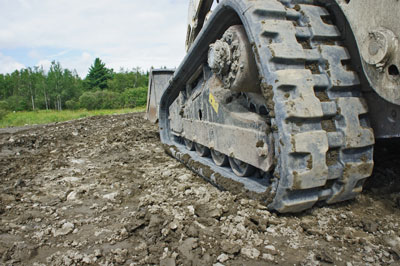Replacement Rubber Track Advice for Track Loaders
Your compact track loader has made it through all kinds of tough conditions and has always delivered. With time however, the normal wear and tear on the tread or inside rolling path of your track becomes evident. Time to replace it. Where do you begin? Well, a basic understanding of what goes into the manufacturing of tracks is as good a place as any. An iron core, steel cables and rubber compounds are the standard components in a compact track loader track. An engineering team’s capacity and creativity in putting these tracks together effectively through a series of complex stages determines the ultimate quality of your track.
What to Consider?

Will This Track Address Your Needs?
Applications are so diverse it’s difficult to find a one-track solution for all applications. However, finding the right track that responds to the surface types your working on is critical. Look for a manufacturer that has a track selection that will cover what we call ‘‘the entire surface spectrum.” That is from lighter applications such as dirt, sand, gravel and asphalt to heavier ones such as concrete, rocks and debris.
How Much Should You Spend?
Track size and type are determining factors in price. Prior to making a decision consider the intended use of your track and the environment your machine will be working in. The frequency with which your machine will be used is also a critical factor. If you anticipate a high usage frequency, you need a high performance track. Go for the track that gives you your lowest operating cost solution. That means pay more upfront for a track to ensure more working hours. Please also consider the terms of the manufacturer’s warranty as your protection against defects in materials and workmanship.
Can You Install Your Tracks?
If you have experience, a track could be switched out with the use of minimal tools in just about an hour. If, however, you have never done it before, seek out the help of an experienced mechanic or technician at your dealership. In addition to switching out your track, you will receive valuable maintenance tips to help maximize the effectiveness of your vehicle and help prolong track life. Dealers will of course also provide valuable advice and guidance on choosing the right track for your machine if you need advice on this as well.
What About Maintenance?
Basic maintenance is required to maximize the life of your track and keep it working effectively. Remember to always put new sprockets with new tracks, ensure proper tension and maintain the undercarriage as clean and in good working condition.
Hugues Lajoie is the product line director of construction tracks at Camoplast Solideal, based in Magog, Quebec.




